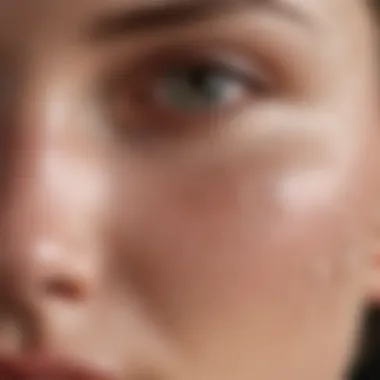Choosing the Right Moisturizer for Blackhead-Prone Skin


Intro
Selecting the right moisturizer is essential for maintaining skin health, particularly for those who experience blackheads. Blackheads form when pores become clogged with excess oil and dead skin cells. For many, this issue is persistent and often frustrating. Understanding how to choose a moisturizer that complements your skin type can lead to smoother, clearer skin. This article tackles the intricate aspects of moisturizer selection specifically for blackhead-prone skin.
We will look into the fundamental causes behind blackheads, the role moisturizers play in ensuring skin hydration, and the ingredients you should prioritize or avoid. In addition, we will provide practical application techniques that can maximize the efficacy of your skincare routine. Expert perspectives will also be included, offering you credible insight to make informed choices tailored to your specific needs.
Understanding Blackhead Prone Skin
Understanding blackhead prone skin is crucial for effective skincare management. Recognizing the nature of blackheads and the associated skin types allows for a more tailored approach to treatment. Blackheads are a common concern that can affect many individuals, especially women aged 18 to 45. Comprehending the skin's behavior, environments, and care regimens can lead to better outcomes.
Defining Blackheads
Blackheads, medically known as open comedones, occur when hair follicles become clogged with oil, dead skin cells, and bacteria. Unlike whiteheads, blackheads remain open at the surface. This exposure leads to oxidation, giving them their signature dark appearance. They are often mistaken for dirt, but the black color is a result of this oxidation process rather than external contaminants. Understanding this definition helps in appreciating the skincare challenges they present.
Causes of Blackhead Formation
Several factors contribute to the formation of blackheads. These include:
- Excess Sebum Production: Overactive sebaceous glands can produce more oil than necessary, leading to clogged pores.
- Hormonal Fluctuations: Changes in hormones, particularly during puberty, menstruation, or due to hormonal medications, can trigger increased oil production.
- Poor Exfoliation: When dead skin cells accumulate without proper exfoliation, they can clog pores and form blackheads.
- Environmental Factors: Pollution and dirt can exacerbate the condition by settling on the skin and contributing to the blockage.
Identifying these causes plays a key role in choosing proper skincare routines and appropriate moisturizers.
Skin Types and Blackhead Susceptibility
Different skin types react differently to external factors, which can influence blackhead formation.
- Oily Skin: This type has a higher tendency for blackheads due to excess sebum production, making it a primary candidate for blackhead issues.
- Combination Skin: Individuals may find blackheads primarily in the oily areas, such as the T-zone, while having drier patches elsewhere.
- Dry Skin: Although less common, blackheads can still form if exfoliation practices are insufficient.
Understanding one’s specific skin type is essential for selecting suitable moisturizers and implementing correct application techniques. With this knowledge, individuals can make informed choices in their skincare routines, particularly concerning moisturizers that will not exacerbate blackhead issues.
The Importance of Moisturization
Moisturization is an essential component of any skincare routine, especially for individuals dealing with blackhead-prone skin. The hydration of the skin is often overlooked during discussions about acne and blackheads. Many assume that keeping the skin dry is a better option for controlling oil and impurities. However, this misconception can significantly impact the overall health and appearance of the skin. Understanding the importance of moisturization can lead to more effective management of blackheads and contribute to healthier skin.
Why Skin Needs Moisture
Skin requires moisture to maintain its barrier functions and overall health. When skin is properly hydrated, it can better resist environmental factors, such as pollution and UV rays, that contribute to aging and skin damage. Additionally, moisturized skin helps in the process of cell turnover, which is crucial for removing dead skin cells that can clog pores and lead to blackheads.
A well-hydrated skin barrier prevents excess oil production. When skin lacks moisture, it may react by producing more oil to compensate, which can ironically lead to more blackhead formation. The cycle becomes a challenging issue that many individuals must confront.
In essence, moisture is crucial for:
- Maintaining elasticity: This helps skin stay firm and youthful.
- Preventing irritation: Hydrated skin is less prone to redness and inflammation.
- Supporting healing: Moisture aids in recovery from blemishes and breakouts.
Moisturizing Myths Debunked
Despite the evident benefits, several myths about moisturizers persist in popular discourse. One common myth is that oily skin does not need moisturizer. This is simply untrue; even oily skin requires hydration. The type of moisturizer differs, but skipping it can worsen blackhead issues.
Another prevalent myth is that heavy moisturizers clog pores. While some ingredients may contribute to clogged pores, many modern formulations are designed specifically to be non-comedogenic, meaning they do not block pores. It is essential to read labels and choose the right products that cater to individual skin types.
Lastly, many believe that moisturizing is only necessary in colder months. In reality, skin can suffer from dehydration year-round. Hot climates, sun exposure, and indoor heating can all contribute to moisture loss. Therefore, adapting your moisturizing routine according to your skin's needs at any given time is vital.


The Role of Moisturizers in Blackhead Management
Moisturizers play a pivotal role in the management of blackhead-prone skin. They help dissolve the buildup of sebum and dead skin cells that contribute to blackhead formation. Utilizing the right moisturizer can help balance oil production, preventing both excess dryness and excess oiliness.
Ingredients such as salicylic acid are particularly beneficial in this context. Salicylic acid, known for its ability to penetrate clogged pores and exfoliate from within, can enhance the effectiveness of a moisturizer. This means that not only does your skin receive the hydrating benefits, but it also gets assistance in blackhead prevention.
In summary, moisturizing is not merely an optional step in the skincare regime; it is a necessity for maintaining healthy skin and managing blackhead issues effectively. Using the right products with targeted ingredients can bring noteworthy improvements to skin texture and clarity.
Choosing the Right Moisturizer
Choosing the right moisturizer is a crucial aspect of skincare for those with blackhead-prone skin. The interactions between moisture, skin type, and product ingredients can significantly influence skin health and appearance. A well-chosen moisturizer can not only hydrate but also support skin's natural defense mechanisms against blackhead formation. This section will explore the essential ingredients to consider, ingredients to avoid, and different product types that can help in maintaining clear skin.
Key considerations include skin type, individual sensitivities, and lifestyle factors. Using the right products can prevent clogged pores and excessive oiliness, thus addressing the root causes of blackheads. Therefore, understanding formulations, ingredients, and proper product types is paramount to establish an effective skincare routine.
Specific Ingredients to Consider
Non-comedogenic Formulas
Non-comedogenic formulas are designed to avoid clogging pores, which is vital for blackhead-prone skin. These products typically use lightweight ingredients that allow the skin to breathe. The concept of non-comedogenicity suggests that certain compounds have less likelihood of causing breakouts. A significant benefit of using non-comedogenic products is that they cater well to those who are acne-prone or have oily skin.
Their unique feature is that they are formulated without heavy oils or waxes that can block pores. However, it is important to note that "non-comedogenic" is not a guarantee; individual reactions may occur.
Hyaluronic Acid
Hyaluronic acid is a popular ingredient renowned for its ability to hold moisture. This humectant can attract water molecules from the environment, making it an effective choice for hydration without heaviness. It's beneficial because it delivers ample moisture while maintaining a lightweight feel, thus not promoting additional oiliness.
Its key characteristic is its versatility; it works well for almost all skin types, including oily and combination skin. A potential downside, however, could stem from its performance in extremely dry environments where it may pull moisture from the skin rather than the air.
Salicylic Acid
Salicylic acid works by going deep into the pores to help prevent the buildup of dead skin cells and excess oils. This beta hydroxy acid is particularly effective for blackhead management. It is favored for its exfoliating properties which promote a clearer complexion.
Its unique feature is its ability to penetrate oil, which helps in reducing blackheads effectively. However, it can be irritating for some, especially in higher concentrations, and should be used with caution.
Ingredients to Avoid
Oily Components
Oily components can exacerbate blackhead issues, as they may increase the likelihood of clogged pores. Many skincare products feature heavy oils, which can feel nourishing yet lead to unwanted shine and breakouts. Avoiding such oils, like mineral oil or coconut oil, can be crucial.
The challenge is to find ingredients that hydrate without contributing to excess oil production. Consequently, formulations that prioritize lighter oils or oil-free components are preferable for those seeking to maintain clear skin.
Heavy Fragrances
Heavy fragrances in products can lead to skin irritation or allergic reactions, especially for sensitive skin. While scents can enhance product enjoyment, they often offer no skincare benefits. Unsuitable fragrances can disrupt the skin’s barrier, negatively impacting moisture retention and overall health.
As a result, opting for fragrance-free or lightly-scented products can be more favorable. Consumers should be cautious and check ingredient lists to avoid potential allergens or irritants.
Certain Alcohols
Certain alcohols, although some are beneficial, can be drying to the skin. Ingredients such as isopropyl alcohol can strip moisture and lead to a compensatory increase in oil production. This reaction could, in fact, create a cycle that promotes blackheads.
The key is to differentiate between alcohols. Fatty alcohols like cetyl alcohol are generally moisturizing, while denatured alcohol may cause irritation. Understanding these differences is essential in selecting the right products.
Product Types: Creams, Gels, and Lotions
When considering product types for blackhead-prone skin, it’s essential to understand the diverse formulations available. Creams, gels, and lotions each serve unique purposes and can benefit various skin types.
- Creams tend to be richer, making them suitable for dry skin but may be too heavy for oily skin.
- Gels are lightweight and often water-based, making them suitable for oily or combination skin.
- Lotions fall in between, offering balanced hydration that can be adjusted according to skin type.
Choosing the correct product type is important to allow for proper moisture retention while minimizing the risk of clogged pores.
Application Techniques
Understanding the application techniques for moisturizers is crucial for individuals with blackhead-prone skin. Correct application can maximize the benefits of the product. It helps to ensure that the skin absorbs moisture effectively, balancing oil without clogging pores.
Proper application techniques can also enhance the effectiveness of other skincare products used alongside moisturizers. Paying attention to how and when to apply moisturizers can lead to clearer, healthier skin.


Proper Method for Application
To apply moisturizer correctly, begin with a cleansed face. Gentle cleansing removes impurities and prepares the skin to better absorb the moisturizer. Use a small amount of moisturizer; often, a pea-sized amount is enough for the entire face.
Dot the moisturizer across your forehead, cheeks, chin, and nose. This helps distribute the product evenly. After that, use your fingertips to gently massage the moisturizer into the skin in upward and outward motions. This technique promotes circulation and helps to stimulate skin cells. Avoid excessive rubbing; this can irritate sensitive skin.
Effective absorption is key to controlling blackheads. Thus, spend an additional moment ensuring full coverage on areas particularly prone to blackheads, like the nose.
Frequency of Use
Generally, it's recommended to moisturize twice a day: once in the morning and once again in the evening. Morning application helps protect the skin barrier against environmental factors throughout the day. Evening application allows for hydration while the skin repairs overnight.
For individuals with oily skin, smaller amounts may suffice during the day, while a more nourishing application might be suitable for the evening. Finding the right balance is key. Monitor your skin's response to determine if adjustments in frequency are needed based on moisture levels or blackhead formation.
Layering with Other Skincare Products
Layering products properly is essential in a skincare routine involving moisturizers and other treatments. Start with lightweight products first and then follow with heavier ones. For example, if you use a toner or serum, apply those before the moisturizer.
It's beneficial to allow each layer to absorb fully before applying the next. This not only maximizes the benefits of each product but also prevents potential clogging of pores. Consider using a lightweight gel moisturizer if layering multiple products. This ensures that skin remains hydrated without the risk of congestion.
Integrating Moisturizer in Your Routine
Integrating moisturizer into your daily skincare routine is essential for maintaining the balance of your skin, particularly for those prone to blackheads. A well-chosen moisturizer can help minimize the appearance of blackheads while promoting overall skin health. It works as a barrier, preventing moisture loss and protecting the skin from environmental stressors. Additionally, it enhances the skin’s texture and can assist in mitigating the effects of excess oil, ultimately leading to clearer skin.
Morning vs. Evening Application
The timing of moisturizer application plays a significant role in its effectiveness. In the morning, a lightweight, non-comedogenic moisturizer can prepare your skin for the day ahead. It hydrates and protects your skin from external pollutants, which can exacerbate blackheads. Choosing a moisturizer with SPF is advisable to shield your skin from harmful UV rays.
In contrast, evening application is just as crucial. Using a richer moisturizer at night can help repair and rejuvenate the skin while you sleep. During this time, your skin undergoes repair processes, and a good moisturizer will support that. You may also incorporate products with active ingredients like salicylic acid or retinol to further target blackhead formation.
- Morning Application Benefits:
- Evening Application Benefits:
- Creates a protective layer against daily aggressors.
- Prepares the skin for makeup if you wear it.
- Hydrates without causing congestion.
- Helps skin repair and regenerate overnight.
- Allows for deeper penetration of active ingredients.
- Provides hydration when the skin is most receptive.
Adjusting Seasonally
Adapting your moisturizer according to seasonal changes is key to managing blackhead-prone skin. During colder months, skin tends to become drier due to reduced humidity levels. In this case, a richer moisturizing cream may be necessary to tackle dryness and prevent barrier damage. Ingredients like shea butter or petrolatum can offer that needed occlusiveness.
Conversely, in warmer months, a lighter gel-based or water-based moisturizer may be more suitable. These formulas hydrate without feeling greasy and help control excess oil production. Ingredients such as hyaluronic acid work effectively to keep the skin hydrated without contributing to breakouts.
"Adjusting your skincare routine with the changing seasons can greatly improve the health of your skin."
To manage blackhead-prone skin effectively, consider the following points in relation to seasonality:
- Winter Considerations:
- Summer Considerations:
- Opt for heavier moisturizers.
- Look for ingredients that lock in moisture.
- Use lightweight, breathable formulas.
- Consider mattifying products to reduce shine.
Incorporating moisturizer properly into your routine, while adjusting for specific needs, is invaluable. As you tailor your approach to be mindful of various factors, you are more likely to achieve clear and hydrated skin, devoid of blackheads.


Expert Opinions and Recommendations
When it comes to managing blackhead-prone skin, expert opinions provide invaluable insights. Dermatologists and consumer feedback often highlight the importance of choosing the right moisturizer as a strategic approach to achieving clear skin. Their recommendations are not merely based on product popularity; rather, they stem from extensive experience and research concerning skin health. By integrating these expert views, individuals can navigate the vast array of skincare products more effectively.
Dermatologist Views
Dermatologists emphasize that moisturization plays a critical role in overall skin health. Many people with oily skin might mistakenly believe they should avoid moisturizers for fear of exacerbating blackheads. However, experts clarify that proper hydration is essential even for oily skin types. Suitable moisturizers can help balance oil production and restore moisture levels.
- Hydration and Oil Control: Many dermatologists recommend non-comedogenic products that hydrate while preventing clogged pores. Ingredients like hyaluronic acid are favored for their ability to attract moisture without adding extra oil.
- Treatment Integration: Dermatologists often suggest integrating moisturizers with active ingredients, such as salicylic acid, into one’s skincare routine. This combination addresses blackhead formation while keeping the skin adequately hydrated.
- The Importance of Texture: The texture of the moisturizer can significantly affect its effectiveness. Gel-based moisturizers are recommended for oily skin as they feel light and absorb quickly without leaving a greasy residue.
"Choosing the right moisturizer is as crucial as incorporating other products in your skincare routine. Always opt for formulations that suit your skin type and needs."
— Dermatologist recommendation
Consumer Insights
Consumer experiences often offer practical perspectives on the efficacy of various moisturizers. Many women aged 18 to 45 report specific trends and preferences in their skincare choices based on personal trial and error, along with their unique skin needs.
- Preference for Lightweight Formulas: Many consumers lean toward lightweight moisturizers. The feeling of heaviness can deter users, especially those prone to blackheads, who prefer clear and smooth skin without additional buildup.
- Feedback on Active Ingredients: Several consumers actively share their results with products containing salicylic acid or tea tree oil that not only hydrate but also treat existing blackheads. This feedback can guide others in making informed decisions.
- Brand Trust and Loyalty: Trust in brands often plays a significant role in purchases. Consumers are likely to follow recommendations from friends, family, or trusted online reviews. Brands that emphasize transparency in their ingredient lists often cultivate a loyal customer base.
In summary, merging the advice from dermatologists with consumer insights equips individuals with a well-rounded understanding of how to effectively choose a moisturizer for blackhead-prone skin. This dual approach addresses professional guidance and practical experiences, helping consumers make informed decisions.
Additional Skincare Tips for Blackhead Prone Skin
Understanding the additional skincare tips for blackhead prone skin is crucial. A holistic approach can enhance the effectiveness of your moisturizing routine. Blackheads are often a result of excess oil and dead skin cells clogging the pores. Thus, implementing supplementary measures can lead to clearer skin.
Exfoliation Practices
Exfoliation is an essential step in managing blackhead formation. Regularly removing dead skin cells can prevent skin from becoming congested. There are two types of exfoliants: physical and chemical.
- Physical Exfoliants: These include scrubs or brushes that manually slough off dead skin. It is important to be gentle to avoid irritation.
- Chemical Exfoliants: Ingredients like salicylic acid and glycolic acid help dissolve the bonds between skin cells. They can penetrate the pores and are often more effective for blackhead prone skin.
Frequency matters. Ideally, aim for exfoliating two to three times a week. However, listen to your skin. If you notice irritation or dryness, adjust accordingly.
Masking and Treatment Options
Incorporating masks into your skincare routine can also play a role in managing blackheads. Masks can offer targeted treatment. Clay masks, for instance, absorb excess oil and draw out impurities from the skin. They are particularly beneficial for those with oily skin types.
- Clay Masks: These masks can be applied once a week for a deep cleanse. Look for ones that contain kaolin or bentonite clay. They help minimize the appearance of pores, making them a solid choice.
- Charcoal Masks: Charcoal can also assist in detoxifying the skin. These masks can pull out impurities, leaving the skin feeling fresher.
- Spot Treatments: In addition to masks, consider targeted treatments for areas with blackheads. Products containing salicylic acid fight against clogged pores effectively and can be applied directly.
Using masks and targeted treatments should complement your regular cleansing and moisturizing routine. Remember, consistency is key when trying to achieve clean and clear skin.
"In skincare, the goal should always be to work with your skin, not against it."
By incorporating these additional tips into your , you can significantly improve skin clarity and health. Engaging with these practices will help to support your existing moisturizing efforts, ultimately leading to better outcomes in the long run.
Closure
In concluding this article, it is vital to reinforce the significance of proper moisturization for blackhead-prone skin. The relationship between moisture retention and skin clarity cannot be understated. While many perceive that oily skin does not require additional moisture, this misconception can lead to a cycle of overproduction of oil and an increased likelihood of blackheads. Therefore, choosing a suitable moisturizer becomes paramount for both balance and addressing the underlying concerns of blackhead formation.
Recap of Key Points
To summarize the key insights presented throughout this article:
- Understanding Blackheads: We defined blackheads and explored their causes, emphasizing that they form due to clogged pores often exacerbated by excess oil and dead skin cells.
- Moisturization Needs: Moisturizers play a crucial role in skin health, maintaining hydration and combating the overproduction of sebum that leads to blackheads.
- Choosing Wisely: Specific ingredients like hyaluronic acid and non-comedogenic formulas are beneficial, while heavy fragrances and oily components should be avoided to reduce the risk of clogging pores.
- Application: Proper techniques and frequency of application influence the effectiveness of moisturizers. Layering with other products must be done cautiously to ensure efficacy.
- Expert Recommendations: We incorporated insights from dermatologists and consumers alike, highlighting effective practices and the experiences of those with similar skin concerns.
- Additional Care Tips: Exfoliating practices and using masks effectively contribute to a clearer complexion.
Encouragement for Personalized Care
Ultimately, every person's skin is unique. It is essential to approach skincare with a mindset that embraces personalized care. What works for one individual may not yield the same results for another. Therefore, keeping detailed notes on what products and techniques provide the best outcomes for your skin is advisable. If necessary, seeking guidance from skincare experts can help tailor a skin regimen that meets specific needs.
Once you find the right balance and routine, the management of blackhead-prone skin will become more intuitive, leading to clearer and healthier skin. Embrace the journey, and give yourself grace as you explore what will serve your skin best.



